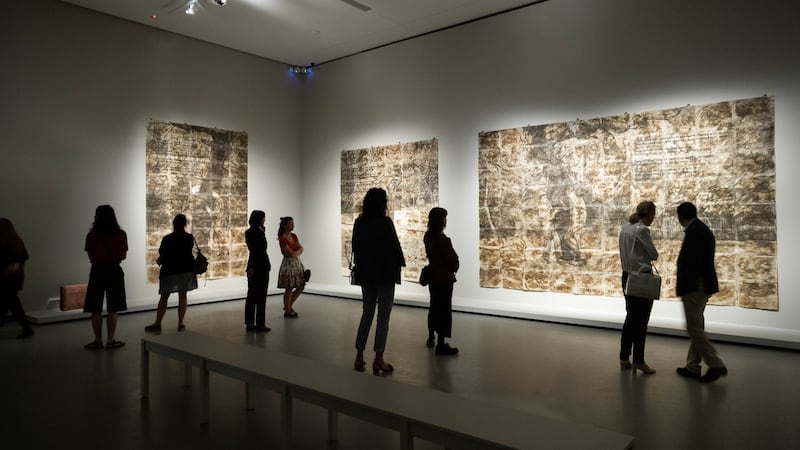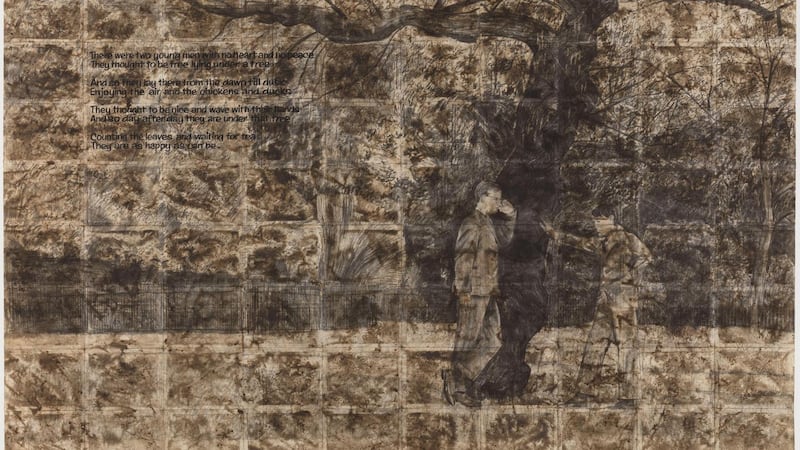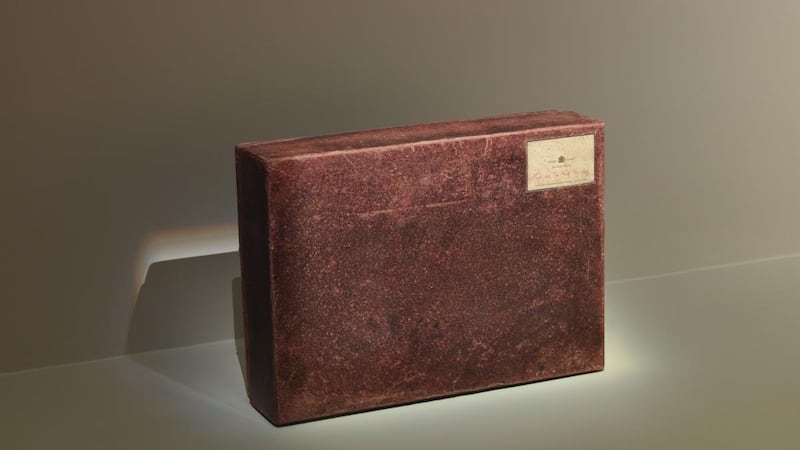The most famous couple in the art world, Gilbert & George seem their habitual debonair selves at a lunch in their honour for the opening of their exhibition, There Were Two Young Men (April 1971), at the Fondation Louis Vuitton in Paris. They're wearing their signature uniform of bespoke "responsibility" suits and identically patterned silk ties in contrasting colours. I'm sitting between the normally inseparable twosome and there is a discernible note of post-traumatic euphoria in their demeanour.
There Were Two Young Men, a massive six-part charcoal-and-paper “sculpture”, was first shown at the Sperone gallery in Turin in 1971, the year Gilbert & George finalised the creation of the series. They had recently graduated from Saint Martin’s art college in London and were at the beginning of their artistic career as Living Sculptures – and three years into their lifelong partnership.
In 1971, they were also broke.
To create a canvas large enough for their work, they taped tens of A3 pages from sketchpads together. The largest individual piece is composed of 80 A3 sheets, and measures 275cm x 445cm. The murals were drawn at speed in charcoal in Fournier Street, their Spitafields home, glazed with a wash of permanganate of potash – a medication used for cleaning wounds – to create a sepia effect, the colour of dead leaves.
Dissembled, the series of A3 panels fitted neatly into a cardboard suitcase, which Gilbert & George had camouflaged with oxblood boot polish to simulate leather.
In 1986, the artists contacted Pierluigi Pero, who had bought the work for the Sperone gallery, with a request to borrow it for an exhibition at the CAPC Museum of Contemporary Art in Bordeaux. However, Pero could not locate it in the gallery’s archive and concluded it had been stolen in the intervening years.
It seemed There Were Two Young Men was lost to the art world until, one evening in 2006, George received a phone call.
“Are you Gilbert & George?” the caller asked. “I think I have something that belongs to you.”
He described the contents to George, who recognised them instantly.
“What should I do?” asked the caller.
“I said, ‘Call the police!’” shouted George.
Emotional encounter
At the Fondation Louis Vuitton Gilbert & George are now setting eyes on this complete work for the first time in 47 years.
“It has been very emotional,” Gilbert tells me. “The last time we saw this was in 1971. It’s a little bit like meeting a friend you haven’t seen in decades.
“This is the first work we made when we became a Living Sculpture. We were forced to walk the streets of London alone. It was all part of growing up. If this work hadn’t been stolen we would have evolved differently.”
“We’re lucky, George says. “The criminal was very careful. Maybe he’s an art collector!”
The recovered seminal work was snapped up by Bernard Arnault for the Fondation Louis Vuitton, where it joins other Gilbert & George pieces in the permanent collection: eight postal sculptures and two video sculptures (all the artists' oeuvre is termed sculpture).

It is not six artworks, it is a single artwork. It's important to us that it stays together and that it is shown in one room
“The Sperone gallery bought it for very little money,” says Gilbert. “We don’t know how much the Fondation Louis Vuitton paid for it. We are not so interested ourselves, we were not involved [in its acquisition]. What is important to us is that this piece is displayed as a single artwork.” This was how it was shown at the Sperone Gallery.
"It is not six artworks," he continues emphatically, "It is a single artwork. Some dealers in New York split up The General Jungle, to make more money. It's important to us that it stays together and that it is shown in one room."
Starchitect Frank Gehry designed the Fondation Louis Vuitton specifically to house large-scale contemporary art, and Gallery 2 on the lower floor, with its gently muted daylight, provides the perfect setting to showcase this fragile monochrome work.
The six monumental “sculptures” that make up There Were Two Young Men are self-portraits of the artists, in a London park with a tree featuring prominently in the centre, symbolising their meeting place, and the strength of their growing relationship.
Each self-portrait is titled in progression: There Were Two Young Men So Polite; There Were Two Young Men Who Were Tired; There Were Two Young Men Who Were Covered in Blood; There Were Two Young Men with No Heart and No Peace; There Were Two Young Men Who Did Laugh; and There Were Two Young Men from Afar.
The besuited figures are stylised and awkward, not completely at their ease. The result is haunting and melancholic, like enlarged pages from a storybook.
Limericks composed by the artists are inscribed on the upper left of the individual panels, with the single exception of the largest, There Were Two Young Men Who Were Covered in Blood, where the limerick appears on the upper right. The text was inscribed by by the same church signwriter who subsequently lettered the 23-part The General Jungle six months after the theft of There Were Two Young Men.
The limericks start out merrily but jar with their slightly sinister discordance.
There were two young men from afar
Who travelled and met with no bar
They went up and down in their way
And attempted to make the world pay
There was no one at all they could blame
Because it just goes this way
They’ve had a few pokes in the eye
But like everyone else they’re not blind
The Arte Povera technique of using taped pages to form a canvas turned out to have a lasting impact on Gilbert & George, as their iconic grid system is a constantly recurring motif in subsequent works, often compared to stained glass.

The feelings of those two young men are still true for us as for everybody. These are sentiments that anyone can feel
Through its sheer scale (the figures and the tree are life-size), There Were Two Young Men produces an immediate and immersive effect on the viewer. This is intentional. Gilbert & George want to make every work of art “a love letter” to the viewer, and to accept the viewer’s feelings as a contribution to the piece.
“The feelings of those two young men are still true for us as for everybody. These are sentiments that anyone can feel,” adds George.
Art as PR
Back to being broke. Gilbert & George created the aforementioned eight-part postal work as their first PR campaign. They sent a personally dedicated limerick every week for eight consecutive weeks to 300 art collectors around the world, postmarked Towards Progress and Understanding in Art, with their respective signatures appearing beneath the words, “Goodbye for now”.
“There were so few galleries in London, so few opportunities. Starting out, we couldn’t afford anything,” says Gilbert. “We made these postal sculptures and sent them out to 300 top art collectors throughout the world.”
“Overnight, we were inside these collectors’ homes,” adds George.
It worked. They secured representation by Konrad Fischer at his Dusseldorf gallery.
“It’s one of our favourite ’70s stories. We were simple-minded baby artists. We were very excited. I think we sold two pictures at the show, our very first sale. The next morning we saw Konrad in the gallery, looking very grumpy. ‘Is there a problem?’ we says, ‘Why are you looking so miserable?’ ‘The cleaning lady liked your exhibition!’ he snarled at us.”
This Dusseldorf exhibition marked their launch as artists internationally. Next stop, Sydney and Melbourne.
“There was no contemporary art in Australia back then,” says George. “We went there and had our show. When it ended, they handed us an envelope. Inside were two tickets to Bangkok. Well, we had never seen anything like it.” He shakes his head, wide-eyed in retrospective awe. “We mark this as the beginning of our bad behaviour.”
I love their suits, I tell them. Perhaps there is a sponsorship deal thy might discuss with Arnault, of LVMH, which also owns Christian Dior, Berluti, Louis Vuitton and Pink)?
“People shout ‘great suits!’ at us from their cars. We get complimented all the time.”
Gilbert & George have lived in London, and have done so for many, many years. I wonder what they think of Brexit?
“Brexit is wonderful,” says George. “We were fine before the Common Market, we were fine during the Common Market and we will be fine after the Common Market. I’m European. Generations of my family fought in wars. We fought for Europe. There is a difference between Europe and the EU.”
“They used to teach us art history when we were baby art students,” says Gilbert. “They only ever talked about European art – da Vinci, Giotto, Picasso. Art was always global. Art should be what a person is.”
Will Gilbert, who was born in Italy, retain his Italian nationality post-Brexit?

We are still outsiders. We still feel we've never really won. We've never really been accepted. We want to win
Of course, he replies, surprised. They exchange a slightly anxious glance. This division of allegiance hadn’t occurred to them.
“Some places are bored with us. Not the UK,” says George. “The UK is more fresh. They’re not bored.”
“We’re spoiled brats, really,” offers Gilbert.
“We are still outsiders. We still feel we’ve never really won,” says George with passion. “We’ve never really been accepted. We want to win.”
What would winning look like?
“To be loved,” says George, “To win and be loved. By men, women and children.”
“We have a lot of enemies,” says Gilbert. “That’s good. You need enemies.”
“We believe in opposition,” says George. “We believe in what we do. We never deviated. Ever. It’s our way of making art.”
“We are weird and normal,” affirms Gilbert. They laugh together. “That leaves us free to create. Empty-headed is good!”
The lunch is coming to an end. There’s a TV crew waiting for a final interview before tonight’s formal inauguration of the show.
“They don’t want to let us go back to the hotel for a rest before tonight,” says George. “I’ve found a way to deal with this. Now, I say, ‘Would you mind? You see, we have to masturbate.’ It works like a charm every time.”
Gilbert & George: There Were Two Young Men runs until August 26th at Fondation Louis Vuitton, 8 Avenue du Mahatma Gandhi, Bois de Boulogne, 75116 Paris fondationlouisvuitton.fr











